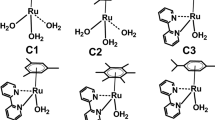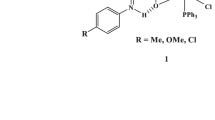Abstract
Rhodium(I) complexes of the type, cis-[Rh(CO)2(amine)2](PF6) where (amine = 3-picoline, 2-picoline, pyridine, 2,6-lutidina or 3,5-lutidine) dissolved in 80% aqueous amine solutions catalyzed the selective reduction of 4-nitrobenzoic acid to 4-aminobenzoic acid under CO atmosphere. The importance of these catalytic systems is their high chemo selectivity for the aromatic nitro group of the 4-nitrobenzoic acid with respect to the carboxylic group, allowing the production of the desired aromatic amine in high yields. The 4-aminobenzoic acid production depends on the nature of the coordinated amine. The Rh/3,5-lutidine system, the most active catalyst among tested, displays turnover frequencies for 4-aminobenzoic acid production of about 173 moles per mole Rh per day for [Rh] = 1 × 10−4 mol, [4-nitrobenzoic acid] = 3.82 × 10−3mol, 10 mL of 80% aqueous 3,5-lutidine, P(CO) = 0.9 atm at 100 °C. Analyses of kinetic results for the Rh/3,5-lutidine system show a first order dependence on 4-nitrobenzoic acid concentration, a non-linear dependence on CO pressure, a segmented Arrhenius plot and dependence on the nature of the reducing gas agent. These data are discussed in terms of a possible mechanism.
Similar content being viewed by others
References
US Department of Health and Human Services. Technical Report Series No 442, 1994.
H. Jurgen (ed) Encyclopedia of Industrial Chemistry, Ullmann's, (Wiley, Florida, 1985).
Y. Shvo and D. Czarkie, J. Organomet. Chem. 368 (1989) 357.
K. Nomura, M. Ishino and M. Hazama, J. Mol. Catal. 66 (1991) L19.
K. Nomura, M. Ishino and M. Hazama, J. Mol. Catal. 78 (1993) 273.
K. Nomura, J. Mol. Catal. 73 (1992) L1.
K. Kaneda, H. Kuwahara and T. Imanaka, J. Mol. Catal. 88 (1994) L267.
V. Macho, L. Vojeek, M. Schmidtova and M. Harustiak, J. Mol. Catal. 88 (1994) 177.
A.B. Taleb and G. Jenner, J. Mol. Catal. 91 (1994) L149.
M.M. Mdleleni, R.G. Rinker and P.C. Ford, J. Mol. Catal. 89 (1994) 283.
F. Ragaini, M. Pizzotti, S. Cenini, A. Abbotto, G.A. Pagani and F. Demartin, J. Organomet. Chem. 489 (1995) 107.
S.A. Moya, R. Sariego, P. Aguirre, R. Sartori and P. Dixneuf, Bull. Soc. Chim. Belg. 104 (1995) 19.
K. Nomura, J. Mol. Catal. A 95 (1995) 203.
F. Ragaini and S. Cenini, J. Mol. Catal. A 105 (1996) 145.
C. Linares, M. Mediavilla, A.J. Pardey, C. Longo, P. Baricelli and S.A. Moya, Bol. Soc. Chil. Quím. 43 (1998) 55.
K. Nomura, J. Mol. Catal. A 130 (1998) 1.
F. Ragaini, S. Cenini and M. Gasperini, J. Mol. Catal. A 174 (2001) 51.
A.J. Pardey, M. Fernández, A.B. Rivas, M.C. Ortega, C. Urbina, D. Moronta, C. Longo, M. Mediavilla, P.J. Baricelli and S.A. Moya, Inorg. Chim. Acta 329 (2002) 22.
C. Linares, M. Mediavilla, A.J. Pardey, P. Baricelli, C. Longo-Pardey and S.A. Moya, Catal. Lett. 50 (1998) 183.
P. Aguirre, S.A. Moya, R. Sariego, H. Le Bozec and A.J. Pardey, Appl. Organomet. Chem. 16 (2002) 597.
C. Longo, J. Alvarez, M. Fernández, A.J. Pardey, S.A. Moya, P. Baricelli and M.M. Mdleleni, Polyhedron 19 (2000) 487.
B. Denise and G. Pannetier, J. Organometal. Chem. 63 (1973) 423.
A.J. Pardey and P.C. Ford, J. Mol. Catal. 53 (1989) 247.
K. Schofield, Hetero-Aromatic Nitrogen Compounds (Plenum Press, New York, 1967) pp. 146–148.
J.C. Miller and J.N. Miller, Statistics for Analytical Chemistry (John Wiley & Sons, New York, 1984).
R.H. Crabtree and D.R. Anton, Organometallics 2 (1983) 855.
Y. Lin and R.G. Finke, Inorg. Chem. 33 (1994) 4891.
A.A. Frost and R.G. Pearson, Kinetics and Mechanism (Wiley, New York, 1961) p. 66.
A.J. Pardey, M. Fernández, J. Alvarez, C. Urbina, D. Moronta, V. Leon, M. Haukka and T.A. Pakkanen, Appl. Catal. A 199 (2000) 275.
G. Fachinetti, T. Funaioli and P.F. Zanazzi, J. Organomet. Chem. 460 (1993) C34.
G. Fachinetti, G. Fochi and T. Funaioli, Inorg. Chem. 33 (1994) 1719.
M.M. Millan, R.G. Rinker and P.C. Ford, J. Mol. Catal. 204 (2003) 125.
S.J. Skoog, J.P. Campbell and W.L. Gladfelter, Organometallics 13 (1994) 4137.
Author information
Authors and Affiliations
Corresponding author
Rights and permissions
About this article
Cite this article
Fernández, C., Lujano, E., Macias, U. et al. Catalytic Reduction of 4-Nitrobenzoic Acid by cis-[Rh(CO)2(Amine)2](PF6) Complexes Under Water–Gas Shift Reaction Conditions: Kinetics Study. Catalysis Letters 95, 143–150 (2004). https://doi.org/10.1023/B:CATL.0000027287.78214.bf
Issue Date:
DOI: https://doi.org/10.1023/B:CATL.0000027287.78214.bf




